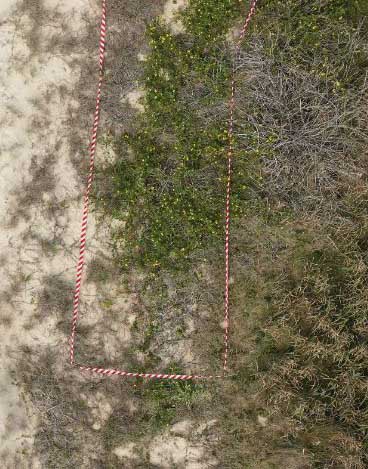The Weed Manager’s Guide To Remote Detection
- Home
- About us
- Detecting weeds
- Get involved
- Resources
The ability to distinguish weeds from other vegetation using remotely sensed imagery is highly dependent on the ability of the sensor to identify the discrete features of target plants. These include the colour or shape characteristics of the target plant, features which largely vary during plant phenological development.
Standard human imagery analysis has historically relied on five principles to identify items on the ground in images.
These are:
This principle still applies to imagery analysis today but the process with weeds is much more complex due to the ever-changing nature of the targeted species.
What makes interpretation of imagery more difficult is the everyday visual interpretation of our surroundings. For one, we lose our sense of depth when viewing a two-dimensional image, unless we can view it stereoscopically so as to simulate the third dimension of height.
The ability to interpret is greatly enhanced when images are viewed in stereo, as visualisation (and therefore, recognition) of targets is enhanced dramatically. Viewing objects from directly above also provides a very different perspective than what we are familiar with.
When you combine an unfamiliar perspective with a very different scale and lack of recognisable detail, and cluttered surrounds, it can make even the most familiar object unrecognisable in an image.
Finally, as humans, we are used to seeing only the visible wavelengths. The ability to visualise wavelengths outside of this window is more difficult for us to comprehend, hence the need for a broad scale intelligent platform to accompany the remote imaging capability.
Recognising targets is the key to interpretation and information extraction. Observing the differences between targets and their backgrounds involves comparing different targets based on any, or all, of the visual elements of tone, shape, size, pattern, texture, shadow, and association. As humans, visual interpretation using these elements is often a part of our daily lives, whether we are conscious of it or not.
Examining satellite images on the weather report, or following high speed chases by views from a helicopter are all familiar examples of visual image interpretation. Identifying individual plants as targets in remotely sensed images based on these visual elements allows us to further interpret and analyse. Remote sensing for weeds uses these same human analysis principles.
When detecting weeds via remote sensing, it is important to first characterise the phenological growth pattern of target plants throughout the year to select the most appropriate stage for imagery capture that most distinguishes the plant from the surrounding vegetation.
Often this is at flowering or fruiting stage, where colour and shape of flowers and fruit enable the target species to appear visually different from surrounding species. Leaf colour changes at different stages of maturity, or due to plant stress or frost impacts, can also provide additional opportunities for imagery capture, if the surrounding vegetation provides sufficient contrast at the time of acquisition.
In cropping situations this is far easier since the surrounding crop typically grows in monoculture and plants move through their growth stages in a more consistent fashion.
In heterogeneous landscapes, where several species cohabit the area, and each with individual phenological stages, identifying target weeds based on a particular phenological stage becomes more difficult and choice of sensor will therefore become more crucial.
Temporal changes in plant features also impact the ability for sensors to distinguish plants from surrounding vegetation, since features also change over time and in response to changes in seasonal conditions.
The ability to collect temporal imagery across a region of interest will therefore provide a more robust training dataset for detection, providing additional opportunities for improving the accuracy of artificial intelligence models as they detect the same plants under a range of conditions.